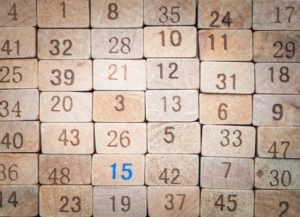 A Lucky 15 bet is part of the world of wagers known as ‘full cover’ bets. This is because you make a selection of four outcomes that you think will be winners and with the Lucky 15 bet it ensures that every possible outcome is covered. There are 15 bets in total, hence the name of the wager, with 4 Singles, 6 Doubles, 4 Trebles and a 4-fold accumulator. As long as one of your selections wins, you will be paid some money – although, generally, you will need more than one to win to get your stake back.
A Lucky 15 bet is part of the world of wagers known as ‘full cover’ bets. This is because you make a selection of four outcomes that you think will be winners and with the Lucky 15 bet it ensures that every possible outcome is covered. There are 15 bets in total, hence the name of the wager, with 4 Singles, 6 Doubles, 4 Trebles and a 4-fold accumulator. As long as one of your selections wins, you will be paid some money – although, generally, you will need more than one to win to get your stake back.
The Lucky 15 isn’t the only type of full cover bet, as we’ll look at in more detail on this page. Different bet types exist depending on the number of selections and whether you want to cover the singles or not.
Obviously you have to pay for each bet in the wager, so a Lucky 15 would cost £15 with a stake of £1 per bet. The more selections you have, the more it will cost to place.
If you are looking for cover bets instead, i.e. wagers with insurance (money back if your horse is second, third, etc.) see our dedicated page.
Full Cover Bets Explained
 A full cover bet is typically one with between three and eight selections in it. The best sport to explain the idea of a full cover bet with is horse racing, given you could choose to place a full cover bet on something like Grand National Day. That’s a day that features 7 races, so you could pick what you think will be the winner for each race and as long as you’re right with one of them then your full cover bet will see you paid something.
A full cover bet is typically one with between three and eight selections in it. The best sport to explain the idea of a full cover bet with is horse racing, given you could choose to place a full cover bet on something like Grand National Day. That’s a day that features 7 races, so you could pick what you think will be the winner for each race and as long as you’re right with one of them then your full cover bet will see you paid something.
The key thing about a full cover bet is that not all of the selections you’ve made have to win in order for you to win some money. In order to understand how that works, you can compare a Treble with a Trixie. A Treble is a bet on three different things happening and all three will need to come in for your bet to be a winner. A Trixie, on the other hand, is a full cover bet that is actually made up of these four bets, 3 Double and 1 Treble.
As long as two of your three selections win then you can get a payout. This obviously increases the likelihood of your bet earning you some money when compared to the Treble. This is an example of a full cover bet without singles, i.e. it only covers doubles and upward.
You could also place a Patent, this is the same as the Trixie except it also covers the three individual singles and is therefore made up of 7 bets in total. A Trixie would cost £4 to place, at £1 / line, and a patent would cost £7. A Patent obviously costs more than a Trixie but it pays out if only one selection wins, although it is unlikely a single winner would cover the complete cost of the bet.
Obviously the more selections you have in your full cover bet, the more it costs and the more complicated things become. A Goliath, for example, involves 247 bets and covers 8 selections, it would cost you £247 if you staked £1 per selection.
You might be wondering why people don’t always place full cover bets, given the amount of leeway they give you. The answer comes in the form of risk and reward. The Treble mentioned a moment ago might be more risky, but because of that the payout is larger. A full cover bet offers more chance than you’ll win overall, which therefore means that the possible payout coming at the end of it is lower each time.
Different Types Of Full Cover Bets
| Bet Type | Selections | Singles | Doubles | Trebles | Other* | Total Bets |
|---|---|---|---|---|---|---|
| Trixie | 3 | 0 | 3 | 1 | N/A | 4 |
| Patent | 3 | 3 | 3 | 1 | N/A | 7 |
| Yankee | 4 | 0 | 6 | 4 | 1 (4) | 11 |
| Lucky 15 | 4 | 4 | 6 | 4 | 1 (4) | 15 |
| Canadian / Super Yankee | 5 | 0 | 10 | 10 | 5 (4), 1 (5) | 26 |
| Lucky 31 | 5 | 5 | 10 | 10 | 5 (4), 1 (5) | 31 |
| Heinz | 6 | 0 | 15 | 20 | 15 (4), 6 (5), 1 (6) | 57 |
| Lucky 63 | 6 | 6 | 15 | 20 | 15 (4), 6 (5), 1 (6) | 63 |
| Super Heinz | 7 | 0 | 21 | 35 | 35 (4), 21 (5), 7 (6), 1 (7) | 120 |
| Goliath | 8 | 0 | 28 | 56 | 70 (4), 56 (5), 28 (6), 8 (7), 1 (8) | 247 |
* (4) Fourfold, (5) Fivefold, (6) Sixfold, (7) Sevenfold, (8) Eightfold
There are a wealth of different full cover bets out there, with only certain ones including Singles. These are the ones that you’d want to turn to for something like Grand National Day, given that even one win will see you get a payout. The various full cover wagers have names, which indicate how many selections they involve or how many bets are placed when taking them out.
The series of bets known as ‘Lucky’ ones, with Lucky 15 being in that group, are ‘Lucky’ because most bookmakers also offer a bonus if a given number of your selections win. If two or more of your selections win, for example, a bookie might offer to pay a 10% bonus on top of your normal winnings. Winning, say, £20 and getting a 10% bonus on top of that to take your winnings to £22 is a very nice addition.
The table above looks at the different types of full cover bets, including how many different bets there are in total for each of them. There are other full cover bets available, but the ones in this table are the most popular.
Looking At A Lucky 15 Specifically
 Now that we know what a full cover bet is and the various types of wagers that you can take out if you decide to go down the road of a full cover option, let’s have a closer look at the Lucky 15 bet specifically and what you can expect to get out of placing it. The fact that it is a full cover bet means that if any of your selections win then you’ll receive a payout, with the payout increasing depending on how many selections win.
Now that we know what a full cover bet is and the various types of wagers that you can take out if you decide to go down the road of a full cover option, let’s have a closer look at the Lucky 15 bet specifically and what you can expect to get out of placing it. The fact that it is a full cover bet means that if any of your selections win then you’ll receive a payout, with the payout increasing depending on how many selections win.
The Lucky 15 wager involves fifteen separate bets rolled into one. They are as follows:
- 4 Singles
- 6 Doubles
- 4 Trebles
- 1 Fourfold accumulator
It is the equivalent of a Yankee bet with four Singles added to it. Let’s say that you’ve chosen four horses from the seven races that take place on Grand National Day at Aintree Racecourse. For the purposes of ease, we’ll call those Horses A, B, C and D. The bets that are included in the Lucky 15 will be as follows:
- A to Win
- B to Win
- C to Win
- D to Win
- A & B to Win
- A & C to Win
- A & D to Win
- B & C to Win
- B & D to Win
- C & D to Win
- A, B & C to Win
- A, B & D to Win
- A, C & D to Win
- B, C & D to Win
- A, B, C & D all to Win
Obviously the nature of the bet means that the more selections you’ve made that win, the more money you stand to win. If all four horses won, for example, then all of your bets would be winners. If, on the other hand, only horse C won then only one of the wagers would be a winning one. Because there are 15 bets, whatever stake you choose to play will dictate how much the bet costs as it will be Stake Amount x 15.
As mentioned elsewhere, the ‘Lucky’ part of the bet comes into play with bookmakers that pay a bonus in addition to your winnings. The bonus that you’ll be paid will vary from bookmaker to bookmaker. Some will over an increasing bonus amount the more wagers you win, for example, whilst others will limit it to say that you’ll get a 10% bonus if all of your selections win. Others will pay double odds if only one wins.
The Lucky 15 bet is a good one to play because it can offer decent returns for a modest investment. 4 winning wagers that each have odds of 4/1, for example, would pay £1,409.50 if your stake was £1, making your total bet £15. Not a bad return on investment even before you add in the 10% bonus on top of that increasing the returns by £140 or so, making it even more worthwhile.
Create Your Own Combination
 Full cover bets are known as package bets and are pre-prepared to allow you to place bets on multiple outcomes easily. This means should you want to cover more than a straight-line accumulator or just singles but you don’t quite want to cover every outcome then you can create your own package yourself.
Full cover bets are known as package bets and are pre-prepared to allow you to place bets on multiple outcomes easily. This means should you want to cover more than a straight-line accumulator or just singles but you don’t quite want to cover every outcome then you can create your own package yourself.
For example, if you place four selections in your bet slip it will show you the odds for the four singles and a 4-fold accumulator. Most of the better bookies will also show you other possible bets, in this case six doubles and four trebles. You could therefore chose to just back the trebles and the 4-fold, for instance. This would be five bets total instead of 15 in a Lucky 15 or 11 in a Yankee.
In this example if you want to only place a certain selection of singles, doubles and trebles then the process is a little more laborious, but still possible. You simply then need to add each bet you want to place to the bet slip in turn and repeat until you have placed all the combinations you want to. It may help to write down the bets you want to place first before doing this, especially if you have a lot of selections.
Taking an example from the way I place these bets. If you have four selections and you are 100% confident in ‘A’, 75% confident in ‘B’, 50% confident in ‘C’ and 25% confident in ‘D’ then you might want to cover them in different ways.
Selection D, an outsider you are least confident in, you might only want to place that in the fourfold. Selection C, which you think is 50:50, you might want that in the fourfold and a treble. Selection B, that you think has a good chance, you want to cover that with everything except a single. Finally selection A you think is a dead cert so cover that across the board. In this case you have the following bets:
- A, B, C, D – Fourfold
- A, B, C – Treble
- A, B – Double
- A – Single
You have now turned 15 bets from a lucky 15, that would cost £15 at £1 / line, into a £4 wager that is more suited to your selections and what you think.
